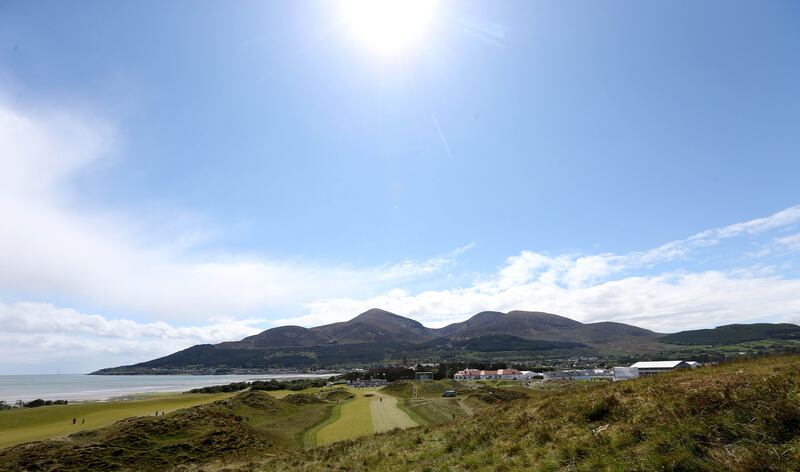The last rounds for members and visitors on the Championship links at Royal County Down were played at the end of August as us mere mortals gave way to the world’s leading players who are ready to contest the Amgen Irish Open.
Ireland’s national Open was last played at the famed links in 2015 when the diminutive Dane Søren Kjeldsen hunkered down and kept his composure while others lost their way amid the brutal squalls that repeatedly rolled off the Mourne Mountains.
Royal County Down is a course capable of doing that to you; minds can be scrambled in an instant, whether on a balmy summer’s evening or in the eye of a storm. RCD has the capacity to be magnificent and brutal in the same sitting.
When in the mood, it offers up birdies aplenty but, be warned, it jostles and infuriates in equal measure. It only takes one wrong links bounce, a seemingly unjust lie, while penal rough and hazards await errant shots.
READ MORE
What magical spell does RCD hold that keeps visiting golfers coming back in their droves? It is just like any other golf course in that it has 18 holes, but it is unlike any other course in the world. Rating golf courses is a futile, entirely subjective, exercise. To simply experience it first-hand is the real joy.
This hacker and member of Mourne Golf Club for 37 years has played the Championship Links and Annesley Links long enough to have witnessed grown men walk down the first fairway backwards as they look back in awe of the backdrop of Slieve Donard, the highest peak in the Mournes.
The championship tee at the iconic par three fourth leaves visiting golfers mesmerised as they marvel at the links beauty that unfolds below them. Or take the top of the ninth hill where the ultimate Kodak moment gives the course rangers palpitations as they try to keep visitor fourballs moving.
Some have been quick to draw criticism of the Irish Open venue that dates back to 1889 when Old Tom Morris first laid out a course through the dunes. Blind tee shots and bearded bunkers are easy targets, especially for visiting stars who failed to come to terms with the unique nature of golf at Royal County Down.
The length of the Championship Links remains largely unchanged in the last 75 years, according to head professional Kevan Whitson.
“The course hasn’t changed massively in length since the 1950s, which is staggering when you think it can still stand up to today’s modern game.”

Yes, there have been upgrades and improvements along the way, but this icon of Irish golf stands tall and continues to occupy the world’s number one spot in leading golf rankings.
The course can stretch to 7,206 yards when the blue tees are tucked into every corner of the property, but length is not RCD’s primary defence, not in this modern game. The player who wins s next week will have found a way to keep it on the short stuff. Those pristine ribbons of fairway cutting through the carnage are the only place from which to build a score. To veer off course is dead. Punters will do well to pick the player who knows how to get it off the tee and keep it in play. Do this and the course becomes eminently scoreable.
What are the obvious pitfalls?
The four par threes will be telling. Royal Troon might have the famous ‘Postage Stamp’ but watch out for the par three seventh, the shortest hole at RCD with the capacity to be its most treacherous – especially in a right-to-left wind. With a brand-new tee complex, it can stretch to some 170-yards but could also play just over 100-yards if required, and either way the greenside run-off left to a cavernous bunker must be avoided at all costs.
The race to the clubhouse for the opening loop of nine doesn’t get any easier as holes eight and nine are two of the most demanding par 4s on the course.
The dog-leg 13th and wonderful par four third must also be treated with respect, but few will argue that the 468-yard par four 15th might trump them all. As the links terrain rises in front of the golfer to a high plateau, it also marks the run for home and is typically into the prevailing wind.
There are pitfalls everywhere, and the fun only keeps going as bunkers left and right are in plain sight for approaches to the green, which also has severe run-offs left and right to place a real premium on accuracy.
So, where might players make up ground?
The par fives (first, 12th and 18th) are obvious candidates with the 18th likely to cough up the fewest chances of birdie or better. The entire length of the finishing hole is protected by bunkers from the tee shot all the way to the green.
Another opportunity could be the short par four 16th, (337-yards) which depending on wind direction could tempt the ‘bombers’ to have a cut at the green with their tee shot.
Like all forms of links golf, the elements will play their part. Benign conditions could leave RCD vulnerable to today’s fairway pugilists as they get the green light to go birdie hunting. However, wind of any sort completely alters playability. So fickle are the vagaries of links golf, conditions can and do change to the rhythm of the local tides rolling into Dundrum Bay.

Perhaps the greatest reminder of RCD’s defence came during our recent final round when pin positions were placed on the subtlest of slopes like upturned saucers towards the front of greens to keep golfing traffic off the putting surfaces in preparation of the Irish Open.
Course manager Eamonn Crawford and his team could have the greens running any pace they wish, but it will be the tournament director and powers-that-be on the DP world Tour who will dictate green speeds, with tournament pin positions very much dependent on daily forecasts.
The stage is set. Mere mortals and local hackers have stepped aside to make way for the big boys to strut their stuff on one of the most famous and unique links challenges of them all.




















